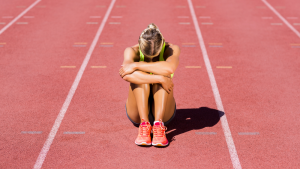Brian Schiff’s Blog
Injury Prevention, Sports Rehab & Performance Training Expert
Over the years, I have been fortunate to work with lots of athletes ranging from youth to professionals. Regardless of age or skill level, I have observed that each one approaches the recovery in their own way. Some are eager to tackle therapy, while others are apprehensive and fearful.

To be clear, the mindset of the patient is as important, if not more important than the physical part of the process as it relates to success. With ACL rehab, I pay close attention at post-op visit number one to determine if the patient is a coper, non-coper or somewhere in between. Having this awareness is crucial as I look to encourage the client and position him/her for success in the fist phase of rehab. The mindset of a patient recovering from their second or third ACL tear may differ greatly than that of a first timer.
With that said, assessing the state of mind of any athlete in the PT clinic is a must. An athlete’s identity, confidence and self-worth is often tied to his/her sport. Injuries separate the athletes from their teams and take away something very important to them. This can lead to depression, anxiety, anger, fear and loneliness to name a few.
It is imperative to connect with an athlete in the first 1-2 visits of rehab. I aim to bond with them and ensure they know I will do everything in my power to get them back to their prior level of performance. Fear of loss is powerful, and I want to partner with them to prevent the loss of playing time as quickly and safely I can though proper rehab.
Improving rotational strength and stability in the torso, shoulders and hips is important for injury prevention and performance. The ability to resist and control rotational loads can reduce stress on the body during transverse plane activities and deceleration during sport. This exercise will demonstrate how to train rotational stability in an unstable manner using water with the Aktiv AQUA Bag. The video below is my latest online column for PFP Magazine.
The water provides an unstable training environment that is effective for beginners and advanced users. You can read the entire online column by clicking here.
I came across some very good reads on Twitter last week week that I wanted to pass along. The first is a blog post by Rich Willy, a PT, professor and researcher who specializes in running and running related injuries. If you or any of your friends have suffered from nagging IT Band pain, this is a must read. In this post, he discusses proper treatment strategies:
The second pearl involves long toss and force on the elbow. Ever wonder how advising a pitcher to reduce his throwing intensity actually impacts velocity and torque on the elbow? It seems that decreasing effort level by 25% and 50% does not equate to the same reduction in actual velocity with a study using the motus sleeve. Read more below:
Baseball Pitchers’ Long Toss Perceived Effort & Actual Velocity
Finally, there has been much discussion about return to sport assessment after ACL reconstruction. Lately, many have begun to question how effective hop testing really is when it cones to determining readiness to return to sport. I use several assessments (one of which is hop testing), but I also feel psychological readiness is crucial.
This article sheds light on the connection between proper single limb landing mechanics and psychological readiness.
Association of Psychological Readiness for RTS after ACLR and Hip and Knee Landing Mechanics
Do you suffer with shoulder instability, shoulder weakness, poor trunk control or chronic shoulder/back pain? One of the biggest issues overhead athletes have is poor proximal stability, often leading to scapular dyskinesia. In turn, undue strain and force can cause stress on the rotator cuff and/or labrum.
In addition, nagging back pain can also occur as a result of repetitive micro-trauma. Improving pillar stability can reduce stress with hyperextension and rotation that creates stress and injuries in the lumbar spine.
This exercise is a unique and challenging way to improve shoulder and torso stability. In some instances, the stress on the wrist can be difficult, and in these cases I suggest using a closed fist on the stationary arm or moving to the knees. It is particularly effective exercise for swimmers, gymnasts, overhead athletes, and anyone with a history of shoulder instability.
One of the great things about being a columnist for PFP Magazine is that I often get to test out the latest fitness equipment on the market. While there are certainly some very gimmicky things out there, I have some ‘go to’ selections in my toolbox, such as the BOSU®NexGen™Pro Balance Trainer. It is the latest version of this training tool.
In my clinic, I rehab lots of athletes suffering from gluteus medius weakness, poor pillar stability and decreased hip stability. Many of my clientele are working to make it back from ACL reconstruction. One of my preferred strengthening exercises to target the shoulder, torso and hips is split squats. Once the client masters proper form on the ground, I move to an unstable setting using the BOSU®.
It is essential to challenge athletes to avoid valgus collapse. The BOSU® introduces instability at the ankle forcing the body to adapt during the split squat movement. Avoiding dynamic valgus and trunk dominance during training will help with injury reduction efforts for the client.
In the video below I produced for my PFP online column, you will see how to use this exercise effectively to improve strength, stability and proprioception.

